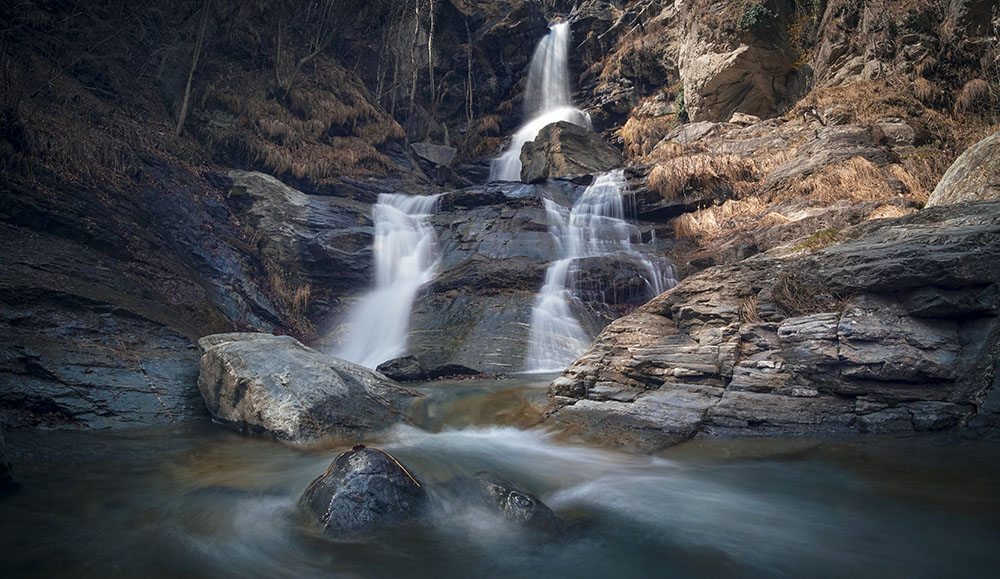
Sony alpha 6000 Samyang 12mm f2,0 (1 sec - f22)
La fotografia di paesaggio è un genere tanto semplice quanto complesso. Il punto è trovarsi nel posto giusto al momento giusto. Scegliere l'ora adatta ad un soggetto in base a come verrà colpito dalla luce. In generale le ore centrali sono da evitare avendo ombre molto nette e poco affascinanti. Le prime ore del mattino o quelle del tramonto sono invece molto più fotogeniche fornendo colori caldi e ombre lunghe. Spesso sono accompagnate da nebbie o brume mattutine in cui filtrano i raggi solari che rendono l'atmosfera ancora più suggestiva. Nell'immagine vediamo ritratta una delle due cascate di Novalesa, in provincia di Torino. Erano le prime ore del pomeriggio. La cascata era completamente in ombra. Questo giocava a mio favore in quanto volevo utilizzare una lunga esposizione per conferire all'acqua quello che si chiama in gergo “effetto seta“. Ovvero utilizzando un tempo di esposizione sufficientemente lungo, diciamo da un ¼ secondo in su, l'acqua con il suo movimento crea un delicato effetto movimento che nella mia visione assomigliava a ciò che percepivo dell'acqua in quell'istante. Immagine completamente diversa sarebbe stata se avessi utilizzato un tempo molto rapido come un 1/1000 di secondo. L'acqua sarebbe stata “bloccata” nel suo movimento dalla velocità dell'otturatore e avremmo visto nitidamente ogni gocciolina. Un effetto molto differente.
Ho quindi impostato la sensibilità ISO della macchina al minimo (100 ISO) per avere un tempo di esposizione sufficientemente lungo. Diaframma completamente chiuso a f22. In questo caso il tempo di esposizione è stato di 1 secondo e ovviamente ho utilizzato un cavalletto per poter tener ferma la macchina. Sono molto comodi anche i cavalletti portatili come i Jobo da appoggiare su una roccia o pinzare su un ramo. Per non muovere la fotocamera al momento dello scatto è meglio utilizzare l'autoscatto o un radiocomando in modo evitare così effetti di micro-mosso.
L'immagine era quasi perfetta così e non ha richiesto molta postproduzione.
Molto utili in questo genere fotografico possono essere dei filtri neutral density che altro non fanno che togliere la luce in eccesso, permettendo tempi di esposizione molto lunghi. Molto interessante provare esposizioni di alcuni minuti su paesaggi con nuvole in movimento. Provare per credere !
Ed ecco una visione di una cascata...
Semplice no ?
©Franco Borrelli. Immagine di proprietà dell'autore.
ENG
Landscape photography is a genre that is as simple as it is complex. The point is to be in the right place at the right time. Choose the right time for a subject based on how it will be hit by the light. In general, the central hours are to be avoided as they have very clear and not very fascinating shadows. The early morning or sunset hours are much more photogenic, providing warm colors and long shadows. They are often accompanied by morning mists or mist in which the sun's rays filter which make the atmosphere even more suggestive. In the image we see portrayed one of the two waterfalls of Novalesa, in the province of Turin. It was early in the afternoon. The waterfall was completely in shadow. This worked in my favor as I wanted to use a long exposure to give the water what is called a "silk effect" in jargon. That is, by using a sufficiently long exposure time, say from a ¼ second upwards, the water with its movement creates a delicate movement effect that in my vision resembled what I perceived of water in that instant. A completely different image would have been if I had used a very fast time like 1/1000 of a second. The water would be "blocked" in its motion by the shutter speed and we would have seen every droplet clearly. A very different effect.
I then set the ISO sensitivity of the camera to a minimum (ISO 100) to have a sufficiently long exposure time. Fully closed aperture at f22. In this case the exposure time was 1 second and obviously I used a tripod to be able to keep the camera still. Portable easels such as the Jobo are also very comfortable to place on a rock or pinch to a branch. In order not to move the camera when shooting, it is better to use the self-timer or a radio control in order to avoid micro-blur effects.
The image was almost perfect that way and didn't take much post-production.
Very useful in this photographic genre can be neutral density filters that do nothing but remove the excess light, allowing very long exposure times. Very interesting to try exposures of a few minutes on landscapes with moving clouds. Seeing is believing !
And here is a vision of a waterfall ...
Simple isn't it?
©Franco Borrelli.
Congratulations @borrellismo! You have completed the following achievement on the Hive blockchain and have been rewarded with new badge(s) :
Your next target is to reach 200 replies.
You can view your badges on your board and compare yourself to others in the Ranking
If you no longer want to receive notifications, reply to this comment with the word
STOPCheck out the last post from @hivebuzz:
Mannaggia sono arrivato in ritardo!! Splendida foto!!